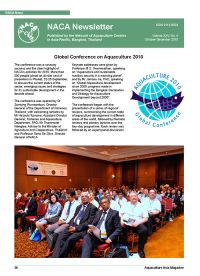In this issue:
Global Conference on Aquaculture 2010. Reducing the dependence on trash fish as feed for marine finfish. 21st NACA Governing Council & 10th Technical Advisory Committee. Training course on application of business management principles in small-scale aquaculture. Sri Lanka Journal of Aquatic Sciences goes open access. Now we're on Facebook too.
Welcome remarks made at the opening ceremony of the Global Conference on Aquaculture 2010 by Dr Somying Piumsombun, Director General of the Department of Fisheries, Thailand.
Welcome remarks made at the opening ceremony of the Global Conference on Aquaculture 2010 by Mr Hiroyuki Konuma, Assistant Director General, Fisheries and Aquaculture Department, FAO.
Welcome remarks made at the opening ceremony of the Global Conference on Aquaculture 2010 by Professor Sena De Silva, Director General of the Network of Aquaculture Centres in Asia-Pacific.
Welcome remarks made at the opening ceremony of the Global Conference on Aquaculture 2010 by Mr Thammarat Wanglee, Advisor to the Minister of Agriculture and Cooperatives, Thailand.
